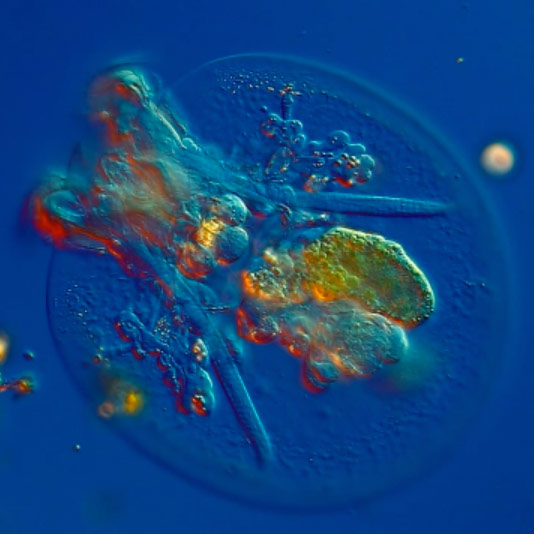Small World in Motion Honorable Mention Winner Highlight: Ralph Grimm

Posted on July 02, 2014
Small Creature Provides Scientist Big Inspiration
When Ralph Grimm sat down at his microscope in early 2013, he expected a leisurely session filming and studying his favorite aquatic creature, the rotifer, having a swim. Instead, he found an animal trying desperately to detach itself from a piece of detritus, struggling against the weight of the debris. Quickly realizing the tiny drama at play, he switched between several magnifications to zoom in and out of the scene, like a filmmaker might, capturing the act until it reached its ultimate conclusion — the rotifer finally gaining “the upper hand” against its unknowing captor and swimming to freedom.
The combination of technique - using two magnifications to capture both the detail of the struggle and the rotifer up close — and artful staging, earned Grimm an honorable mention in the Nikon Small World in Motion competition. It is this type of sharp eye for aesthetics, combined with skilled scientific know-how, that is the hallmark of the Nikon Small World In Motion competition (and its sister competition, Nikon Small World.)
As a teacher of fine arts at a high school in Queensland, Australia, Grimm is not a scientist by trade. However, he has practiced microscopy since childhood — encouraged first by his parents — and used it to satisfy a lifelong love of learning about the visible, and invisible, world around us.
“There are so many things happening under the microscope that are thoroughly ignored by a lot of people,” says Grimm. “They’re scared of the words education and science, thinking it sounds boring or it’s all viruses and bacteria — creatures that are small and dangerous. However, there is so much inherent beauty and mystery - even just plain cuteness. I liked that my video shows my own humorous take on these themes.”
Grimm was also pleased to showcase his favorite microscopy subject, the rotifer. “Rotifers are fascinating. They’re almost completely transparent, so unlike almost any other creature on earth, their inner organs are completely accessible to deeper observation.”
Additionally, the creatures are incredibly good swimmers — able to maneuver in multiple directions and in varying speeds — seemingly without effort. Says Grimm, “From a bio-technology perspective, the study of rotifers often leads me down new lines of thinking that keep me stimulated and always wanting to learn more. On top of that, the biomechanical principals and mechanisms displayed by rotifers could be used for future designs of submersibles and robotic technology.”
Grimm entered the Nikon Small World In Motion Competition, because he wanted the general public to understand that the world under the microscope — the struggles, the joy, the humor, seeing life at work—is a microcosm of the world outside. He hopes to change the perception of science education as something scary or boring, and reveal the beautiful, hidden world waiting to be discovered just beyond the naked eye.
“Education is about more than just earning a degree or getting a job. For me, it’s about adventurous enquiry into the world around us that can lead to great discoveries in the future,” says Grimm. “There’s a hidden world that deserves to be appreciated and recognized as another level of life. Education gives us the power to uncover it.”
